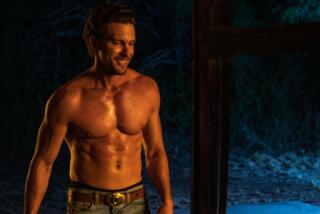TV Picks: ‘A Christmas Story,’ a ‘Lucy’ memory, snowy ‘Lilyhammer’
24 hours of “A Christmas Story” (TBS, Tuesday and Wednesday). Jean Shepherd’s hardy holiday classic turns 30 this year. (I will pause for those who need to sit for a second in order to take that number in.) Adding tradition to tradition, TBS will again air the film for 24 hours straight, 12 times in a row, beginning at 8 p.m. Christmas Eve; some brave souls may take this as a challenge -- a triple-dog-dare challenge. (Anyone up wrapping presents at 4 a.m. should at least appreciate the company.) Like many of the most enduring cultural artifacts, “A Christmas Story” is made from humble stuff, with quiet genius. Peter Billingsley, put on Earth for the role, plays Ralphie, a surrogate for Shepherd’s childhood self, whose only desire is a Red Ryder BB gun with a compass in the stock and this thing that tells time; there is none of your supernatural seasonal special-effected stuff here, only Ralphie’s occasional daydreams and Pascal’s-Wager, back-pocket belief in Santa Claus. His parents, played by a smartly teamed Darren McGavin and Melinda Dillon, are unglamorous, exhausted, unfussily loving. Although wreathed in nostalgia -- the story takes place somewhere around 1939, 1940, as near as I can figure -- it might be a story of anyone’s childhood or Christmas. Director Bob Clark (whose previous big hits were “Porky’s” and “Porky’s II,” confoundingly) keeps things straightforward and simple, and works at a child’s-eye level, just as Shepherd’s narration avoids adult hindsight/insight.
That the film has spread wide Shepherd’s hip-homey voice, a great instrument of improvisational 20th century storytelling, is reason enough to celebrate it. Many of his radio broadcasts are available to hear at the website www.flicklives.com, including “Flick’s Tongue,” whose matter “A Christmas Story” incorporates.
“I Love Lucy Christmas Special” (CBS, Friday). The Ricardos and the Mertzes, whom you should already know well if you care anything at all about television, return to network prime time this week in an hour-long special cobbled together from a 1956 holiday episode (itself cobbled together from clips from earlier episodes) and “Lucy’s Italian Movie,” with its famous grape-trampling scene. In order to spare younger viewers psychological discomfort and to make the whole thing seem even more of an event than any random half-hour of “I Love Lucy” is to start, it has been (mostly) colorized, or re-colorized; the holiday episode was given that treatment -- less well, I assume -- for an earlier broadcast. (The flashback scenes in the Christmas “clip show” are presented in black and white, to represent past time, evidently, and possibly to afford some relief to those of us who find the gray scale of the original sufficiently beautiful to behold. Or maybe it’s just a nod to “The Wizard of Oz.”) Added color may or may not make the past more present, but it will surely not dim the brilliance of Lucille Ball, Desi Arnaz, Vivian Vance and William Frawley, as formidable and funny a quartet as the medium has ever mustered.
PHOTOS: Families that changed TV
“Lilyhammer” (Netflix, now and forever). “House of Cards,” sure, whatever. The first Netflix original is this culture-clash comedy, already on its second season, with Steve Van Zandt, of the E-Street and “Sopranos” gangs, back as New York wiseguy-on-ice Frank “The Fixer” Tagliano, in witness protection in Lilehammer, Norway. (Just go with it.) With dialogue in Norwegian and English -- it airs in Norway as well -- it’s a true co-production, not an American remake or remodel of a Scandinavian original, with differently shaded meanings for its constituent audiences. From here, it plays as a sort of fish-out-of-water-in-the-snow story; from there, as a tale of social integration and distrust in a country that until relatively recently was racially and culturally homogenous, and also of an unruly force abroad in a land long on regulations. (Frank is, of course, a cut-to-the-chase kind of guy.) The show is, to be sure, whimsical; Frank is in a long tradition of comical gangsters whose brutality and lack of personal nuance is mitigated by their being kind of cute -- Van Zandt makes a better romantic lead than one might imagine -- and often morally (if not ethically) in the right. In the first season, Frank had to come to terms with his environment; now his environment has had to come to terms with him. He’s an established citizen, with a successful nightclub, a piece of this and that, a half-competent local crew, a girlfriend (Marian Saastad Ottesen) and twins about to be baptized -- plenty of room for further complication, in other words.
More to Read
The complete guide to home viewing
Get Screen Gab for everything about the TV shows and streaming movies everyone’s talking about.
You may occasionally receive promotional content from the Los Angeles Times.







